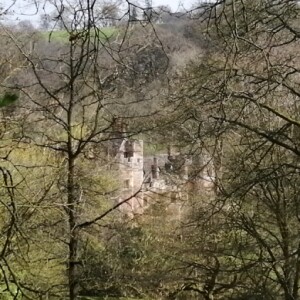Well-balanced
Ride a cock-horse to Banbury Cross,
To see a fine lady upon a white horse;
One theory has it that this should actually be
To see a Fiennes lady
a reference to Celia Fiennes, born in the 17th century, who explored England on horseback at a time when women did not do such things. She was a scion of the well-known family whose contemporary members include Ranulph, Ralph and Joseph. The Fiennes family, more properly the Twisleton-Wykeham-Fiennes family, are holders of the hereditary title 'Baron Saye and Sele'. The family seat is Broughton Castle, a few miles away, between here and Banbury
A while ago we attended a talk by the 'heir presumptive' (you have to get into the patois when you interact with these people) to the title - it means he will get the title when his father (currently 103) dies. He works in city finance and, in fact, played a role in channeling venture capital into the Astra-Zeneca research that eventually developed the Covid vaccine. He was actually an amusing speaker - telling the tale of an ancestor who eloped to Gretna to marry an actress (such irony) and was banished to the colonies for the rest of his life by the family
An aside during his talk revealed that his family has had a few run-ins over the centuries with the equally blue-blood Compton family - otherwise titled the Marquis of Northampton. These families date back to the 13th and 14th century; the Compton family own a country house called Compton Wynyates, which is also nearby, and have been continuous occupiers there since the turn of the 13th century
One of the Comptons was a page, and a genuine childhood friend, to Henry VIII, which did the family no harm at all. He developed an existing property into a fortified castle, with turrets, castellated walls, two moats and drawbridges. It became a place visited frequently by Tudor and Stuart monarchs: Henry VIII, Elisabeth, James I, Charles I. Notwithstanding the fortification, the family were tipped out by Cromwell's army and lived in exile until the restoration, after which their fortunes were restored, and the family wealth now runs to well over £100 million
Remarkably, the Tudor House is almost untouched since the fortification during Henry's reign, unlike almost all other country houses of this age. This must make it one of the most historically significant buildings in the country. I cycled past it today. In the winter, it's just possible to glimpse the house through the bare trees (extra), but there is no public access, and it is never now opened to public view (there has been some limited access in the past). There are the usual 'strictly private' signs, cameras and electronic gates
I'm not going to rant on about inequality and the scandal of the British class system - you've heard it all before, and I have nothing new to add. One little detail that I spotted amused me. The current Marquis, much of whose wealth and privilege derives from the patronage of Henry VIII, remember, is currently enjoying his sixth marriage, which had so far yielded him a single male heir
The main picture is in the nearby Warwickshire hamlet of Winderton - about which I have been able to discover nothing remarkable. It is a connoisseur's backwater, a place of the most picturesque dereliction, with exquisite brick and stone buildings losing roofs, windows and pointing. This A-frame barn stands right beside to lane, and appears to be used only as a car-port. It may not be a Tudor mansion, but it is less camera-shy


Comments
Sign in or get an account to comment.


